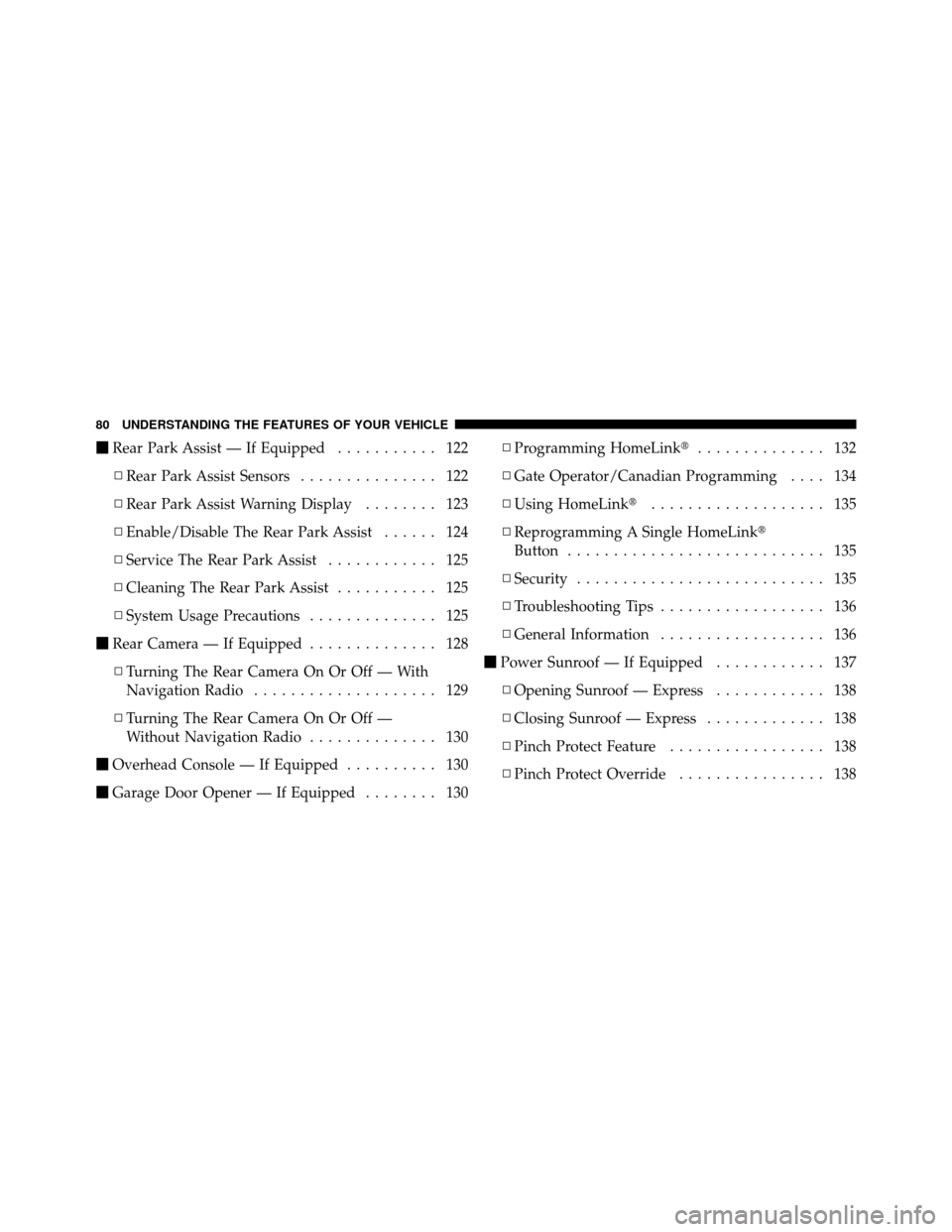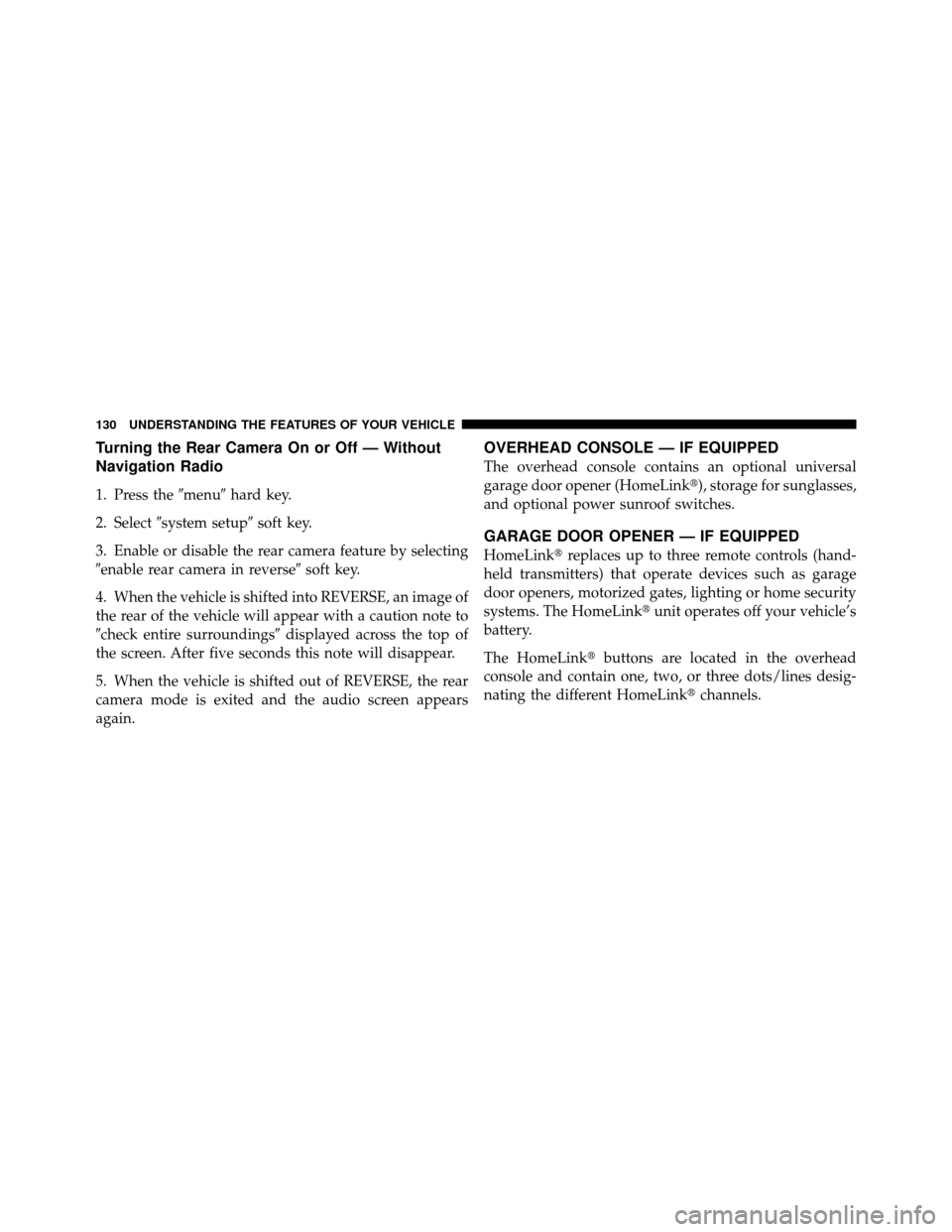Page 53 of 460

Along with seat belts and pretensioners, Advanced Front
Airbags work with the knee bolsters to provide improved
protection for the driver and front passenger. Side airbags
also work with seat belts to improve occupant protection.
Knee Impact Bolsters
The Knee Impact Bolsters help protect the knees of the
driver and the front passenger, and position everyone for
the best interaction with the Advanced Front airbag.
Here are some simple steps you can take to minimize the
risk of harm from a deploying airbag:
Children 12 years old and younger should always ride
buckled up in a rear seat.
WARNING!
Infants in rear-facing child restraints should NEVER
ride in the front seat of a vehicle with a passenger
front airbag. An airbag deployment can cause severe
injury or death to infants in that position.
Children that are not big enough to wear the vehicle seat
belt properly (see Section on Child Restraints) should be
secured in the rear seat in child restraints or belt-
positioning booster seats. Older children who do not use
child restraints or belt-positioning booster seats should
ride properly buckled up in the rear seat. Never allow
children to slide the shoulder belt behind them or under
their arm.
If a child from 1 to 12 years old (not in a rear facing child
seat) must ride in the front passenger seat, move the seat
as far back as possible and use the proper child restraint.
(Refer to information on Child Restraints in this section.)
2
THINGS TO KNOW BEFORE STARTING YOUR VEHICLE 53
Page 63 of 460

4. Otherwise required by law.
Data parameters that are recorded:
•Diagnostic trouble code(s) and warning light status for
electronically-controlled safety systems, including the
airbag system
•Vehicle speed
•Engine RPM
•Brake switch status
•Pedal position
•And other parameters depending on vehicle
configuration
Child Restraints
Everyone in your vehicle needs to be buckled up all the
time, including babies and children. Every state in the
United States and all Canadian provinces require that
small children ride in proper restraint systems. This is the
law, and you can be prosecuted for ignoring it.
Children 12 years and younger should ride properly
buckled up in a rear seat, if available. According to crash
statistics, children are safer when properly restrained in
the rear seats rather than in the front.
There are different sizes and types of restraints for
children from newborn size to the child almost large
enough for an adult safety belt. Always check the child
seat Owner’s Manual to ensure you have the right seat
for your child. Use the restraint that is correct for your
child.
2
THINGS TO KNOW BEFORE STARTING YOUR VEHICLE 63
Page 66 of 460

locking retractor, pull the belt from the retractor until
there is enough to allow you to pass through the child
restraint and slide the latch plate into the buckle. Then,
pull the belt until it is fully extracted from the retrac-
tor. Allow the belt to return to the retractor, pulling on
the excess webbing to tighten the lap portion around
the child restraint. For additional information, refer to
�Automatic Locking Mode�earlier in this section.
•In your vehicle’s 2nd row outboard seating positions,
you may have trouble tightening the lap/shoulder belt
on the child restraint because the buckle or latch plate
is too close to the belt path opening on the restraint.
Disconnect the latch plate from the buckle and twist
the short buckle-end belt several times to shorten it.
Insert the latch plate into the buckle with the release
button facing out.
•If the belt still cannot be tightened, or if pulling and
pushing on the restraint loosens the belt, disconnect the latch plate from the buckle, turn the buckle
around, and insert the latch plate into the buckle
again. If you still cannot make the child restraint
secure, try a different seating position.
•Buckle the child into the restraint exactly as the
manufacturer’s instructions tell you.
•When your child restraint is not in use, secure it in the
vehicle with the seat belt or remove it from the vehicle.
Do not leave it loose in the vehicle. In a sudden stop or
collision, it could strike the occupants or seatbacks and
cause serious personal injury.
NOTE: For additional information, refer to
www.seatcheck.org or call 1–866–SEATCHECK. Cana-
dian residents, should refer to Transport Canada’s web-
site for additional information. http://www.tc.gc.ca/
roadsafety/safedrivers/childsafety/index.htm
66 THINGS TO KNOW BEFORE STARTING YOUR VEHICLE
Page 68 of 460

LATCH — Child Seat Anchorage System (Lower
Anchors and Tether for CHildren)
Your vehicle’s second row seat is equipped with the child
restraint anchorage system called LATCH. The LATCH
system provides for the installation of the child restraint
without using the vehicle’s seat belts, instead securing
the child restraint using lower anchorages and upper
tether straps from the child restraint to the vehicle
structure.
LATCH-compatible child restraint systems are now avail-
able. However, because the lower anchorages are to be
introduced over a period of years, child restraint systems
having attachments for those anchorages will continue to
also have features for installation using the vehicle’s seat
belts. Child restraints having tether straps and hooks for
connection to the top tether anchorages, have been
available for some time. For some older child restraints,
many child restraint manufacturers offer add-on tetherstrap kits or retro-fit kits. You are urged to take advantage
of all the available attachments provided with your child
restraint in any vehicle.
NOTE:
When using the LATCH attaching system to
install a child restraint, please ensure that all seat belts
not being used for occupant restraints are stowed and out
of reach of children. Remind all children in the vehicle
that the seat belts are not toys and should not be played
with, and never leave your child unattended in the
vehicle.
The second row outboard and center seating positions
have lower anchorages that are capable of accommodat-
ing LATCH-compatible child seats having flexible,
webbing-mounted lower attachments or fixed lower at-
tachments. Regardless of the type of lower attachment,
NEVER install LATCH-compatible child seats such that
two seats share a common lower anchorage.
68 THINGS TO KNOW BEFORE STARTING YOUR VEHICLE
Page 72 of 460

the buckle, turn the buckle around, and insert the latch
plate into the buckle again. If you still can’t make the
child restraint secure, try a different seating position.
To attach a child restraint tether strap:
Route the tether strap over the seatback and attach the
hook to the tether anchor located on the back of the seat.For the outboard seating positions, route the tether over
the head rests, and attach the hook to the tether anchor
located on the back of the seat.
WARNING!
An incorrectly anchored tether strap could lead to
increased head motion and possible injury to the
child. Use only the anchor positions directly behind
the child seat to secure a child restraint top tether
strap.
Transporting Pets
Airbags deploying in the front seat could harm your pet.
An unrestrained pet will be thrown about and possibly
injured, or injure a passenger during panic braking or in
a collision. Pets should be restrained in the rear seat in
pet harnesses or pet carriers that are secured by seat belts.
Tether Strap Mounting
72 THINGS TO KNOW BEFORE STARTING YOUR VEHICLE
Page 80 of 460

�Rear Park Assist — If Equipped ........... 122
▫ Rear Park Assist Sensors ............... 122
▫ Rear Park Assist Warning Display ........ 123
▫ Enable/Disable The Rear Park Assist ...... 124
▫ Service The Rear Park Assist ............ 125
▫ Cleaning The Rear Park Assist ........... 125
▫ System Usage Precautions .............. 125
� Rear Camera — If Equipped .............. 128
▫ Turning The Rear Camera On Or Off — With
Navigation Radio .................... 129
▫ Turning The Rear Camera On Or Off —
Without Navigation Radio .............. 130
� Overhead Console — If Equipped .......... 130
� Garage Door Opener — If Equipped ........ 130▫
Programming HomeLink� .............. 132
▫ Gate Operator/Canadian Programming .... 134
▫ Using HomeLink� ................... 135
▫ Reprogramming A Single HomeLink�
Button ............................ 135
▫ Security ........................... 135
▫ Troubleshooting Tips .................. 136
▫ General Information .................. 136
� Power Sunroof — If Equipped ............ 137
▫ Opening Sunroof — Express ............ 138
▫ Closing Sunroof — Express ............. 138
▫ Pinch Protect Feature ................. 138
▫ Pinch Protect Override ................ 138
80 UNDERSTANDING THE FEATURES OF YOUR VEHICLE
Page 130 of 460

Turning the Rear Camera On or Off — Without
Navigation Radio
1. Press the�menu�hard key.
2. Select �system setup� soft key.
3. Enable or disable the rear camera feature by selecting
�enable rear camera in reverse� soft key.
4. When the vehicle is shifted into REVERSE, an image of
the rear of the vehicle will appear with a caution note to
�check entire surroundings� displayed across the top of
the screen. After five seconds this note will disappear.
5. When the vehicle is shifted out of REVERSE, the rear
camera mode is exited and the audio screen appears
again.
OVERHEAD CONSOLE — IF EQUIPPED
The overhead console contains an optional universal
garage door opener (HomeLink�), storage for sunglasses,
and optional power sunroof switches.
GARAGE DOOR OPENER — IF EQUIPPED
HomeLink� replaces up to three remote controls (hand-
held transmitters) that operate devices such as garage
door openers, motorized gates, lighting or home security
systems. The HomeLink� unit operates off your vehicle’s
battery.
The HomeLink� buttons are located in the overhead
console and contain one, two, or three dots/lines desig-
nating the different HomeLink� channels.
130 UNDERSTANDING THE FEATURES OF YOUR VEHICLE
Page 131 of 460
NOTE:HomeLink� is disabled when the Vehicle Secu-
rity Alarm is active.
WARNING!
•Your motorized door or gate will open and close
while you are training the Universal Transceiver.
Do not train the transceiver if people or pets are in
the path of the door or gate. Only use this trans-
ceiver with a garage door opener that has a “stop
and reverse” feature as required by federal safety
standards. This includes most garage door opener
models manufactured after 1982. Do not use a
garage door opener without these safety features.
Call toll-free 1–800–355–3515 or, on the Internet at
www.HomeLink.com for safety information or as-
sistance.
•Vehicle exhaust contains carbon monoxide, a dan-
gerous gas. Do not run your vehicle in the garage
while training the transceiver. Exhaust gas can
cause serious injury or death.
HomeLink� Buttons
3
UNDERSTANDING THE FEATURES OF YOUR VEHICLE 131